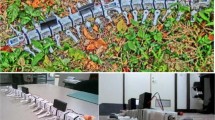Abstract
Myriapoda, having multitudes of legs and an elongated body, can dexterously travel on natural environments. Myriapod locomotion has an advantage over wheeled and tracked vehicles on a rough terrain, because each leg can discretely contact the ground at several points. The authors have attempted, therefore, to develop a light, simple, and adaptive myriapod robot, i-CentiPot, in accordance with the implicit control law given by passive dynamics, which achieved significant mobility against unpredictable environment. The physical model, i-CentiPot 01, showed that the body undulation emerged because of the leg wave, which was similar to that of a real centipede. However, the mechanism of the body undulation was not revealed. This study, therefore, aims at developing a dynamic model of the myriapod robot using frictional force and elucidating how it locomotes.







Similar content being viewed by others
Explore related subjects
Discover the latest articles, news and stories from top researchers in related subjects.References
Manton S, Harding M (1952) The evolution of Arthropod locomotory mechanisms—Part 3. The locomot Chilopoda and Pauropoda. J Linnean Soc Lond Zool 42(284):118–167
Anderson BD et al (1995) Axial kinematics and muscle activity during terrestrial locomotion of the centipede scolopendra heros. J Exp Biol 198:1185–1195
Pfeifer Rolf, Bongard Josh (2006) How the body shapes the way we think: a new view of intelligence. A Bradford Book, The MIT Press.
Koh D, et al (2010) Centipede robot for uneven terrain exploration: design and experiment of the flexible biomimetic robot mechanism, In: Proc. of the 2010 3rd IEEE RAS & EMB, Intl. Conf. on Biomedical Robotics and Biomechatronics, pp.877-881
Saranli U et al (2001) RHex: a simple and highly mobile hexapod robot. Intl J Robot Res 20(7):616–631
Hoffman Katie L, Wood Robert J (2011) Passive undulatory gaits enhance walking in a myriapod millirobot. In: 2011 IEEE/RSJ International Conference on Intelligent Robots and Systems, pp.1479-1486
Aoi S, Egi Y, Tsuchiya K (2013) Instability-based mechanism for body undulations in centipede locomotion. Phys Rev E 87(1):012717-1-11
Aoi S et al (2016) Advantage of straight walk instability in turning maneuver of multilegged locomotion: a robotics approach. Sci Rep 6:30199
Kano T et al (2017) Decentralized control mechanism underlying interlimb coordination of millipedes. Bioinspirat Biomimet 12:036007
Yasui K et al (2016) On the common decentralized control mechanism underlying centipede and millipede locomotion. Proc. SICE SI Symp 2016:2776–2779
Gakken Holdings Co., LTD., Mechamo\(\cdot\)Centipede,http://otonanokagaku.net/products/mechanic/centipede/detail.html. Accessed 9 July 2020
Osuka K, et al (2017) Development of Implicit Controlled Centipede Robot (i-CentiPot). In:Proc. of SICE Symposium on Decentralized Autonomous Systems:18-23
Kiungasa T et al (2017) Development of a small and lightweight myriapod robot using passive dynamics. Artif Life Robot 22(4):429–434
Kinugasa T et al (2017) Myriapod Robot i-CentiPot via passive dynamics—emergence of various locomotions for foot movement. In: Proc. of SICE AC 2017
Janosi Z, et al (1961) The analytical determination of drawbar pull as a function of slip for tracked vehicles in deformable soils. In: Proc. of ISTVS1st Intl. Conf.: 707-736
Author information
Authors and Affiliations
Corresponding author
Additional information
Publisher's Note
Springer Nature remains neutral with regard to jurisdictional claims in published maps and institutional affiliations.
This work was presented in part at the 25th International Symposium on Artificial Life and Robotics, Beppu, Oita, January 22–24, 2020, and supported by CREST, JST, and JSPS KAKENHI No. 17K06281.
About this article
Cite this article
Miyamoto, N., Kinugasa, T., Amasaki, T. et al. Analysis of body undulation using dynamic model with frictional force for myriapod robot. Artif Life Robotics 26, 29–34 (2021). https://doi.org/10.1007/s10015-020-00610-w
Received:
Accepted:
Published:
Issue Date:
DOI: https://doi.org/10.1007/s10015-020-00610-w




